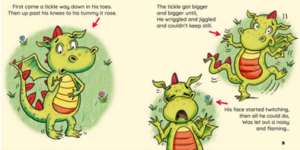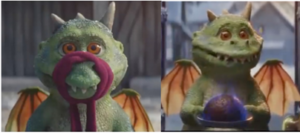Evans v John Lewis Plc & Anor
Written by Bethan Clarke James | May 2, 2024
Excitable Edgar, the mischievous dragon and star of the 2019 John Lewis Christmas advert, captured the hearts of many – except, that is, for Fay Evans. The children’s book author, who self-published her title ‘Fred the Fire-Sneezing Dragon’ in 2017, believed that John Lewis and their advertising company (adam&eveDBB) had copied her character and infringed her copyright by using Excitable Edgar in their advert and a subsequent book. And so ensued proceedings issued against John Lewis and DBB UK Limited, with the defendants also bringing a counterclaim seeking positive declaration that they had not infringed Ms Evans’ copyright.
Ms Evans claimed that there were striking similarities between the character she and her illustrator created, Fred the Fire-Sneezing Dragon, and Excitable Edgar. Attempting to rely on s.16(2) of the Copyright, Designs and Patents Act 1988 (CDPA), Ms Evans submitted that the similarities could only have been achieved by John Lewis copying her work.
Fred the Fire-Sneezing Dragon

Excitable Edgar

Excitable Edgar (Spin-off Book):

There was no doubt that copyright subsisted in Fred the Fire-Sneezing Dragon and so the key point of discussion in this case was whether John Lewis did in fact copy Ms Evans’ work. The answer lay in considering the similarities between the two characters and, most importantly, establishing whether John Lewis had the access to Ms Evans’ book to enable them to copy.
It was submitted by the claimant that both characters were child-sized and green, with spikes on their head and back, with a ribbed front and 2 arms. While the court found some parallels, the sizes of the dragons were not similar enough to presume copying, the green colour of both characters was not deemed to be an expression of intellectual creation and that when the characters were viewed as a whole they were not sufficiently similar. The claimed narrative similarities were judged in the same manner – parallels were coincidental, rather than as a result of copying.
However, the similarities, or lack thereof, become inconsequential when Her Honour Judge Melissa Clarke found that it could not be inferred that John Lewis accessed Ms Evans’ work before creating Excitable Edgar. John Lewis and adam&eveDBB produced a research document, which laid out their due diligence searches, a research schedule and an outline from 2016 of their initial ideas for Excitable Edgar. In essence, the idea for Excitable Edgar had been formed in the year before Ms Evans published ‘Fred the Fire-Sneezing Dragon’.
Further, employees at both John Lewis and adam&eveDBB were unlikely to have had access to the children’s book, which sold very few copies in primary schools in North West England. The court could neither directly establish nor infer the defendants’ access to Ms Evans’ title.
The court ruled that John Lewis did not copy ‘Fred the Fire-Sneezing Dragon’ and so did not infringe Ms Evans’ copyright. John Lewis were also granted a declaration of non-infringement and an order for Ms Evans to publicise the judgment.
Comments
The case demonstrates the importance of diligent notetaking and documenting throughout the creative process, which can prove vital in defending your creations.
Conversely, this case is also a useful reminder that before alleging copyright, it is crucial to consider whether your own work precedes that which you believe to be a copy.
Fundamentally, HHJ Melissa Clarke cemented the fact that: “There can be no copyright infringement without copying, and there can be no copying if the work alleged to have been copied has not been accessed…”.

